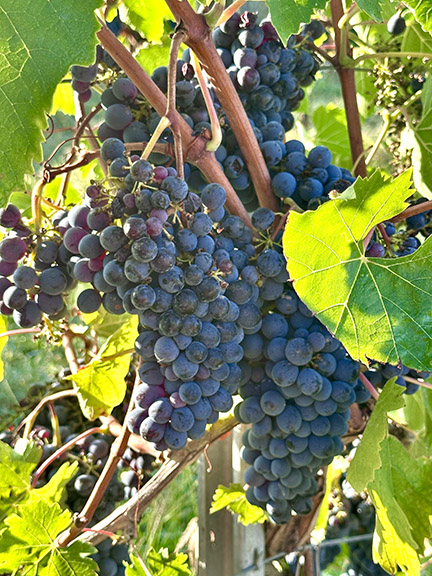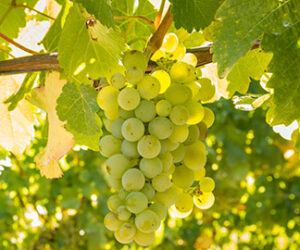One of the most iconic lines of modern cinema, could easily be, “I ate his liver with fava beans and a nice Chianti.” While I don’t condone Hannibal Lecter’s pairing of human flesh with one of the world’s most famous wines, I do understand his point. Chianti, comprised primarily of the Sangiovese grape, is one of the most well-reputed and traditional food-friendly wines in the world today. Even as a kid, I remember going to dinner with my parents at the local pizzeria, and my father, typically more of a beer drinker, would always order a glass of Chianti with his meal. When I asked him why he was having wine, he would respond, “It makes the food taste even better.” And he was correct. The beautiful acidity and ripe red fruit flavors of Sangiovese make it an incredibly food-friendly wine, pairing up beautifully with tomato-based sauces, vinegars, and meats of any variety.

The early Etruscans were known to cultivate wine grapes, possibly Sangiovese, in central Italy, potentially dating back to the eighth century B.C. While there isn’t direct grape DNA evidence of Sangiovese vines as we know today dating back to that time, samples in artifacts show many similar DNA markers to modern Sangiovese. These vines have been an integral part of the Italian landscape and winemaking since before Italy was Italy as we know it today. The earliest records of the grape we now know as Sangiovese begin in the eighteenth century in Italy. The name Sangiovese is said to be derived from the early Latin “sanguis Jovis” or “blood of Jupiter,” the supreme god of ancient Roman mythology.
Modern DNA research has shown the genetic origin of Sangiovese to be a spontaneous cross of Ciliegiolo and Calabrese di Montenuovo. Ciliegiolo is a rather well-known ancient variety of Tuscany, whereas Calabrese di Montenuovo is almost extinct and originates from Calabria. Nowadays, Sangiovese is planted worldwide, most famously in Italy, but also having large plantings in the United States, Argentina, and Australia. It is the predominant grape of central Italy and Tuscany, and it has become a part of such famous Italian wines as Chianti, Brunello di Montalcino, Vino Nobile di Montepulciano, and Morellino di Scansano. Italian wines are classified and often named by region rather than varietal, hence Sangiovese arriving to the Italian dinner table under various nomenclature.
In the Vineyard
Sangiovese does best in rocky, crumbly soil with large amounts of stones and gravel. The soils of Tuscany are commonly referred to as Alberese soils, dating back over 50 million years to the Eocene era, and composed primarily of limestone. The craggy, stony composition of the soil encourages the roots to grow deep, searching for water and nutrients. The high porosity rate of the soil provides excellent drainage and causes the plant to struggle enough to generate very concentrated fruit. The limestone is formed from the decomposed ancient remains of sea life that most likely covered the peninsula of Italy millions of years ago. These remains solidified into limestone that now generates grapes with high acidity, soft tannins, and excellent potential for long-term aging.
Trellising systems vary for Sangiovese, from traditional pergolas used in small, family vineyards, to large vertical shoot position (VSP) trellising systems of large, commercial wineries. The vines are known to be very vigorous and require heavy pruning after the winter and then shoot thinning in the spring as the vines develop. Cane thinning may also be conducted in the late spring if the shoot thinning is overlooked or not severe enough. Foliage is very abundant with Sangiovese and leaves will need to be pulled closer to veraison. Without the shoot or cane thinning, the vines tend to overproduce. They have been known to produce up to 15 tons per acre if these techniques are not implemented. Overcropping will result in a decrease in phenolics and less sugar accrual as the season progresses. In most areas of Italy, farmers aim to produce 3-4 tons per acre to maintain the complex flavors and aromas that the prized grape is famous for.
There is a wide variance in types of Sangiovese available to the modern viticulturalist, with over 650 different clones being identified. The University of Florence has contributed to the increase in Sangiovese quality with its clonal research. Since the 1980s, the University of Florence has isolated, identified, certified, and then propagated clones of Sangiovese, and then made them available to commercial wineries around Tuscany, which elevates the overall quality of the resulting wines by proliferating the best quality clones. This isolation and propagation of the Brunello clone has led to its travel around the world in plantings in the New World as well as Old.
So why does my dad (and millions of others) always order a Chianti with his Italian dinner? The grape has a rather unique ability to hold its acidity as it ripens, giving it a terrific palate cleansing quality. The acidity is a beautiful pairing to tomato-based sauces and can cut through the richness of oil and cream-based sauces as well. Boasting generous amounts of red fruit character, Sangiovese entices drinkers with notes of sour cherry, raspberries, earth, and tobacco. It even can have tomato leaf and green pepper notes in years where it is less ripe, which can be a nice savory element to a finished wine. Various clones of the vine and terroir have a large impact on resulting wine flavors. In warmer climates such as Australia and California, flavors of raspberry, strawberry, and plum emerge, creating a very fruit-forward wine. In higher altitudes and cooler climates of Italy and Argentina, the cooler weather generates a thicker skin and higher acidity. These wines will have a sturdier tannic punch to their finish, with excellent body. They tend to have a bit more herbaceous and earthy notes of white pepper, tomato leaf, black tea, and figs.
In the Winery
Brunello, a Sangiovese-based wine that is one of Italy’s most expensive and prestigious, is grown in a specific area of Tuscany known as Montalcino. The mountainous area of Montalcino is rich with loose gravelly soils that provide excellent drainage for the grapevines, resulting in a very concentrated fruit. The lack of rain in the area further concentrates the fruit, as opposed to other areas of Tuscany that receive 30% more rain on average annually. The lower yield/more concentrated fruit still maintains that incredible acidity along with superb tannic structure, lending to the incredible aging capacity of Brunello wines. The Brunello clone of Sangiovese has been brought to America and can be sourced for the home winemaker who is thirsty for a wine with long-term aging potential.
When crafting a Sangiovese at home, it is important to grab a few bottles made around the globe and try them, to choose a style of Sangiovese that you like. Once you have flavors and structures in mind that you would like to achieve, you can then speak with your local home winemaking shop or grape source about procuring the best grapes to fit that flavor profile.
In the home winery, I would choose a yeast strain that further promotes the style you are trying to achieve. BM 4×4 is an excellent yeast strain isolated from Montalcino, home of Brunello. It has a unique quality that will help to diminish or mask the green character sometimes found in Sangiovese, which can be very helpful if dealing with grapes grown in a cooler climate or during difficult ripening conditions. MT48 is another yeast strain that will work very well for this variety. It helps to promote red fruit character and spicy notes, both of which are typical of a warmer climate Sangiovese. This strain also is a low producer of volatile acidity (VA), which can be helpful as well, provided it is used with a proper nutritional program. If Brix levels are very high at crush, consider using yeast strain Rhône 2226, as it has the capability to ferment to 17% ABV and will preserve the varietal character and enhance the structure of the wine.
Home winemakers should consider the addition of oak very carefully and be mindful not to distract from the nuance of the fruit. I would advocate for the use of oak dust at fermentation to provide additional sacrificial tannins throughout the process, preserving the structure and body of the resulting wine. While the wine will certainly benefit from barrel aging, the winemaker may want to shy away from a new barrel. The new barrel may be too powerful for the more delicate wine, adding too much flavor too quickly, before the desired amount of reduction is gained. Sangiovese is a superb candidate for a second-year barrel, gently imparting oak flavor, but more importantly allowing for the micro-oxidation and reduction to gently give the wine structure over time. I would advocate for neutral barrel aging with oak chips so extensive bench trials may be conducted; dialing in the amount of oak flavor precisely to enhance and complement the fruit and acidity of the wine, rather than risk overpowering it.
Whether taking on a multi-year aging project for a Brunello style or crafting an easy-drinking Chianti-style wine to be enjoyed with pizza and friends, Sangiovese will yield terrific fruit, palate cleansing acidity, and many delicious food pairings.
Sangiovese Recipe Yield 5 gallons (19 L)
Ingredients
125 lbs. (57 kg) Sangiovese grapes
Sanitizing solution of potassium metabisulfite (KMBS)
KMBS powder and citric acid powder
5 g yeast (BM 4×4, MT80, or Rhône 2226)
Liquid pectic enzyme
7.5 g Go-Ferm Sterol Flash
7.5 g Fermaid O
5 g Fermaid K
5 g Opti-Red (optional but helps)
5 g Booster Rouge (optional but helps)
5 g oak dust, French medium+ toast
1 small packet of MLF bacteria (Wyeast liquid cultures)
Distilled water
American or French Medium oak chips, cubes, or spirals
Equipment
Crusher/destemmer
Wine press
15-gallon (57-L) fermentation bucket
5-gallon (19-L) carboy
Airlock and bung
Auto-siphon and tubing
Stir paddle
Spray bottle
pH meter
Hydrometer
Spoon and small mixing bowl
Thermometer (digital preferred)
Glass marbles (optional)
Step by step
1. Ensure all your equipment is clean and in proper working order. Make a fresh batch of KMBS sanitizing solution using 1 Tbsp. of KMBS powder and 1 Tbsp. of citric acid mixed into 1 gallon (3.8 L) of clean water. Fill a spray bottle with the KMBS/citric acid solution and spray
down your processing equipment. Ensure there is no pooling of sanitizer in bins or press basins.
2. If using fresh grapes, crush and destem and transfer immediately into a sanitized 15-gallon (57-L) fermenter bucket.
3. Add 50 ppm of KMBS to kill off natural yeast. Utilize the sulfite calculator at
winemakermag.com/sulfitecalculator to assist in your calculations. Throw a cover on the must bucket and allow to sit overnight in a cool area. This will kill off negative microbes and allow the must to come to a temperature of 60 °F (16 °C).
4. The next morning (12 hours after the addition of KMBS), add five drops of pectic enzyme per gallon (3.8 L) of must and stir well. Add the oak dust and stir well.
5. Take measurements of your juice, including volume, Brix, pH and TA. Adjust the juice to have a starting Brix of at least 24, and a pH of 3.5–3.6, and TA of 6–7 g/L. Use tartaric acid if needed to increase acidity. www.wineadds.com has helpful calculators for adjusting acidity in must.
6. To prepare the yeast, warm 50 mL of distilled water to 60 °F (16 °C) and add to the mixing bowl. Then add the Go-Ferm Sterol Flash. Stir well. Then add five grams of yeast and stir well. Allow to sit for 15 minutes. Then mix in to the must with a sanitized stir paddle.
7. Place a lid on the fermentation pail loosely and wait 24 hours to observe yeast activity. Take Brix measurements twice daily via a hydrometer to ensure the start of fermentation. When obtaining samples for Brix measurements, strain the solids out of a sample of must using a sanitized strainer and pour the liquid into your hydrometer jar or beaker. Using the thermometer, take temperature measurements daily. Try to keep the fermentation between 70–85 °F (21–29 °C) to help secure color but also avoid off-aromas. To do this, you may need to put the fermentation bin in a cool area of your basement, outdoor porch, or refrigerator, or in a larger bin (garbage pail) filled with ice water.
8. Punch down the cap and aerate the must three times a day at a minimum to help avoid reductive characters. Adding the yeast nutrients at their appropriate times will also help to avoid reductive characters.
9. After one or two days of fermentation, check the Brix and if it has dropped by one or two degrees, it will be time to add nutrients. Add 100 mL of distilled water to a mixing bowl and add 7.5 g of Fermaid O and the Opti-Red and Booster Rouge if you choose to use them. Mix well to create a slurry and then stir into the fermenting juice with a sanitized stir paddle.
10. Continue to monitor Brix and temperatures daily (twice daily would be preferred). When the Brix has fallen to between 15–11°Brix, add the Fermaid K in the same way you added the Fermaid O.
11. When the temperatures are between 75–80 °F (24–27 °C) and the alcoholic fermentation is well underway, wipe the Wyeast MLF packet with a cloth wetted with sanitizing solution. Pitch ML bacteria and stir to punch down the skins and incorporate the bacterial cultures.
12. Continue to ferment as close to 80 °F (27 °C) as possible until the wine has fermented to dryness (-1 to -2 °Brix). This should take 7–21 days.
13. When the wine has achieved dryness, press out the wine in a sanitized press and pour all of the wine into a 5- or 6-gallon (19- or 23-L) carboy to complete its malolactic fermentation (MLF). Make sure to affix a bung and airlock to prevent oxidation and allow the MLF to off gas.
14. After 5–7 days, rack off the lees into a clean, sanitized carboy. Affix bung and airlock and allow to sit for a month. If you have an air gap after racking, either top off with a complementary wine such as commercially made Sangiovese or Chianti, or add sanitized glass marbles to displace the headspace.
15. Monitor the MLF via paper chromatography or measure the reduction of malic acid via a meter to track the progression of the fermentation. When the MLF is complete, rack the wine and add 50 ppm of KMBS.
16. One month after the initial racking and addition of KMBS, rack it again into a sanitized carboy and add another 50 ppm of KMBS. Consider degassing at this point, briskly stirring with a wine whip during a racking session. Always be careful when using this tool in a glass carboy. Consider racking it into a food-grade bucket and degassing in that. Never put a glass carboy under suction or negative pressure.
17. While the wine is aging, consider the addition of oak chips, cubes, or staves to add a bit of oak to enhance the wine. Run bench trials to determine the proper dosage of oak. Taste often to not over-oak the wine.
18. Allow the wine to sit and age, maintaining a free SO2 level appropriate for the pH. The WineMaker sulfite calculator will help you determine the proper dosage given the parameters of pH and volume. You can filter the wine after 8 months of aging if you choose. At this point, it should have been racked approximately four times and have completed its oak aging.
19. Consider cold stabilizing or acquiring a cold stabilizing product such as Zenith Color. This product may only be used if the wine is filtered down to 0.5 micron as turbidity will interfere with its effectiveness. If filtration is not available, try to cold stabilize via exposure to cold (put wine in a plastic container, do not try to cold stabilize in a glass carboy).
20. Once cold stability has been achieved via physical or chemical means, taste the wine and consider if it is ready to bottle. Fining agents such as Super Kleer or mouthfeel enhancers such as gum arabic may help to improve mouthfeel and clarity.
21. Bottle once you are content with the flavor and stability of the wine. Always add a small amount of sulfite before bottling, 10 ppm beyond the sulfite calculator’s recommended value, to account for oxygen uptake during the bottling process.






